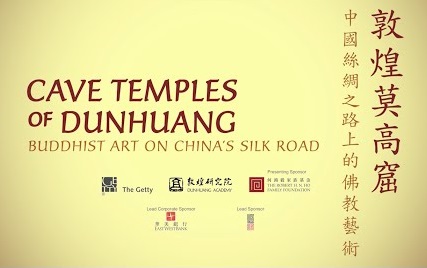In May 2016 the Getty will introduce visitors to the spectacular Mogao caves, an ancient Silk Road site dating from the 4th to 14th centuries. Visitors will explore the tremendous significance of the diverse art and artifacts from this UNESCO World Heritage site, and learn about the challenges faced in its preservation. Replicas of three of the nearly 500 decorated Buddhist cave temples that survive today will allow visitors to experience what it is like to visit the site.

Organized by the Getty Conservation Institute, the Getty Research Institute (GRI), the Dunhuang Academy, and the Dunhuang Foundation, Cave Temples of Dunhuang: Buddhist Art on China’s Silk Road celebrates the over 25 years of collaboration between the GCI and the Dunhuang Academy to conserve and protect this World Heritage site.
“This exhibition is the product of years of hard work and cooperation between the Getty Conservation Institute and their partners in Dunhuang to conserve the extraordinary legacy of the Mogao caves, arguably the most important and beautiful pictorial evidence of the transmission of Buddhism along the Silk Road,” says Jim Cuno, President and CEO of the J. Paul Getty Trust.
With their exquisite wall paintings and sculptures, the Mogao caves bear witness to the intense religious, artistic, and cultural exchanges along the Silk Road, the trade route linking East and West. Three full-size cave replicas, hand painted by artists at the Dunhuang Academy, will be installed on the Getty Center’s plaza, allowing visitors to experience the cave temples for themselves and to learn about their conservation.
“The Dunhuang Academy is delighted to be partnering with the Getty Conservation Institute, the Getty Research Institute, and the Dunhuang Foundation in this major exhibition, the first comprehensive display in the United States on the ancient cave temples of Mogao,” says Wang Xudong, director of the Dunhuang Academy. “Since 1989 the Dunhuang Academy and the Getty Conservation Institute have worked together on the conservation and management of the site and in so doing have forged an enduring bond of friendship. Not only will the exhibition bring to the American public the artistic beauty of this World Heritage Site but it will serve also as a model for international collaborations.”
The exhibition will continue in the GRI galleries, with art and objects from the site that reflect the diverse ideas, beliefs, and artistic styles found in the cave temples. The exhibition will include paintings on silk, textiles, drawings, and manuscripts on loan from the British Museum, the British Library, the Musée Guimet, and the Bibliothèque nationale of France—objects that have rarely, if ever, traveled to the United States. Also on view will be rare books and maps from the GRI’s Special Collections.
Among the objects to be exhibited is the Diamond Sutra (a sacred Mahayana Buddhist text) that dates to the year 868. Coming to the Getty on a loan agreed in principle with the British Library, the Diamond Sutra is the world’s oldest dated complete printed book. It was found in Cave 17, also known as the Library Cave, where some 50,000 objects, sealed up for a millennium, were discovered in 1900.
Source: The Getty [July 14, 2015]
VIA «Getty Museum to present 'Cave Temples Of Dunhuang: Buddhist Art On China’s Silk Road'»